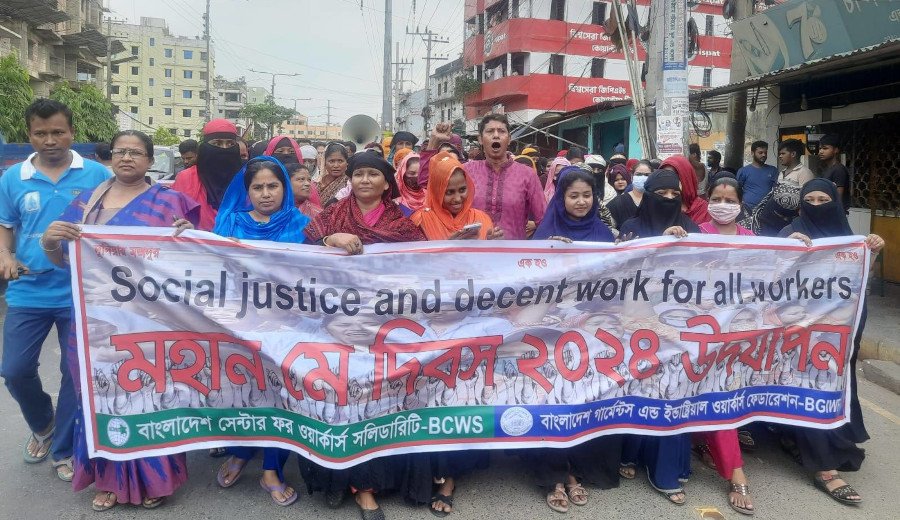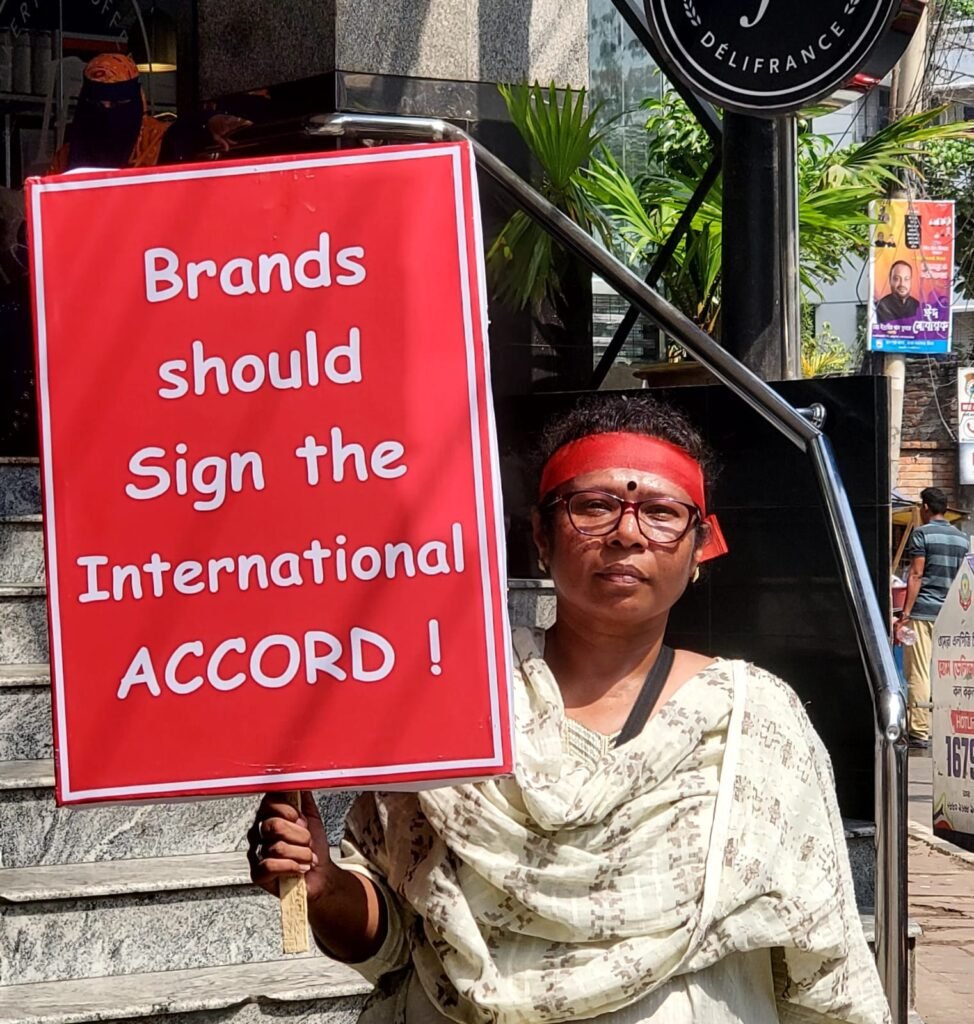Rana Plaza: Garment workers are still fighting for fair wages

Story by Leila Hawkins
Photo: Union & labour right organisations protests on labour day 2024. Protest for social justice and decent work in Chittagong/Chattogram, Bangladesh / BCWS – BGIWF.

Twelve years on from the Rana Plaza disaster where 1134 people died in the building’s collapse, garment workers in Bangladesh are still fighting for a living wage – and being violently punished for it.
“My dear colleague Shahidul Islam was killed in front of the factory where he represented workers only two years ago,” says Kalpona Akter, founder of the Bangladesh Centre for Worker Solidarity.
Islam, a 45-year-old union organiser, was beaten to death by a group of men outside the Prince Jacquard Sweater factory on the outskirts of Dhaka. He was there to speak to the factory’s management on behalf of its workers, who had not been paid for over two months.
An initial police report stated that his attackers had been rebuking him for demanding wages as they beat him unconscious. To date, there has been no resolution to the investigation into his murder, and despite calls for compensation to be paid to his widow and children, no such support has materialised. “Still, most of the brands that sourced from this factory, such as New Yorker and Lager 157, have done nothing to compensate his widow for her terrible loss,” Akter says.
Far from being an isolated incident, Islam’s murder was part of a sequence of attacks on workers and union organisers that continues to this day. The Rana Plaza tragedy, one of the deadliest industrial disasters of modern times, may have sparked a global reckoning over the conditions garment workers were subjected to, but their exploitation continues in factories that supply some of the world’s most well-known clothing brands.
The worst disaster in the history of the textile industry
Bangladesh is the second largest apparel exporter in the world, after China. Famous clothing brands source garments from factories located here, attracted by cheap labour and manufacturing. As a result, the garment industry accounts for more than 80% of the country’s total export revenue.
But the Rana Plaza disaster in Dhaka highlighted how factories were cutting corners on workers’ safety.
In April 2013, deep structural cracks were discovered in the walls of the eight-story building, where clothing for brands including Benetton, Mango, Walmart and JC Penney was produced. Workers were evacuated but asked to return the following day, with reports that some managers threatened to withhold wages or fire those who refused to go back.
On the same day they returned the walls collapsed, leading to the deaths of 1,134 people and a further 2,500 injured. Around 80% of the victims were women, many of whom were in their early 20s.
A later investigation found that the top floors of the building had been constructed illegally and were not suitable for factory facilities.

Following the tragedy, the Accord on Fire and Building Safety in Bangladesh was established to set health and safety standards, including removing locks from doors, installing fire-rated doors, conducting checks on electrical systems and evacuating structurally unsafe premises until safe again. It has been signed by hundreds of brands, covering more than 1600 factories.
Akter says there have been notable improvements to working conditions on the premises covered by the agreement. “Over 2 million people are working in a safer place. I believe that [we will not] experience anymore Rana Plaza, at least in Bangladesh. It’s also less expensive than individual audits. The brands that have signed Accord are running these inspections collectively which is accepted by everyone including workers and trade unions.”
However some brands continue to rely on voluntary self-checks. “I don’t understand how someone who saw that this improvement can happen is still resistant in signing this agreement, yet Kontoor Brands like Wrangler and Lee, Decathlon, IKEA and Amazon are among the brands that refuse to sign,” she says.
The struggle for a living wage
A living wage has long been a key demand for garment workers, many of whom live below the poverty line despite regularly working 14-hour days.
“It will make a difference for millions of workers’ lives if their parents or they themselves could be receiving the living wage,” Akter says. “If the workers at Rana Plaza had living wages, they would not have cared if the factory management would say that they are not going to pay for the month’s salary if they did not re-enter the factory.
“I would not have been a child labourer if my mother was getting a living wage,” she adds.
Akter says that on their current salaries workers cannot afford to feed their families healthy meals, send their children to school, or afford healthcare. “The housing system is so bad, most are [living in] 10 by 10 foot rooms which sometimes don’t have windows. They contribute to the global supply chain, but are struggling to survive. This is unacceptable. The cost of living continues to rise every day, making their situation even more difficult.”
In the aftermath of Rana Plaza, many brands promised to start paying workers a living wage, but Akter says that so far no brand has followed up on this. “When we asked brands to support the workers’ demand for a new monthly minimum wage of 23,000Tk (equivalent to £138.64), which is still far below a living wage, the brands remained silent and the new minimum wage ended up at 12,500Tk (£75.35). They say countries set living wages not brands, but brands set the low prices for garments, and countries are afraid to lose their business.
“H&M is the best example, who in 2013 promised to do this within five years, but when we started asking they backtracked on their promise and removed the original document. Many brands say workers have to fight for living wages through their unions, but how can they if they do not have the freedom to organise?”
There have been numerous reports of peaceful protesters being met with police brutality over the years. Among these was the November 2023 protest, where thousands of Bangladeshi garment workers took to the streets to call for an end to poverty wages. During a clash with the police four workers lost their lives, 131 people were arrested, and approximately 40,000 people were charged with a criminal offence.
Following campaigns from the Clean Clothes Campaign, Amnesty International and other advocates, 10 cases have been dropped to date, freeing tens of thousands of workers from the threat of imprisonment. However 26 cases remain unresolved, involving factories that supply several major fashion brands.
The brutal crackdown on unions
Akter notes that while joining a trade union became easier in the years immediately after the Rana Plaza disaster, it now carries huge risks including threats, discrimination, false criminal charges and even violence.
“The kinds of largely trumped up, legal charges brought against workers vary widely, ranging from vandalism and obstruction of police to attempted murder in a few cases,” she says. Most of these alleged crimes carry long prison sentences. In extreme cases even life-long prison sentences. All workers arrested during the protests have been released on bail and as far as we know, no workers have been arrested for any of the alleged crimes since.”
“Also, criminal cases by garment factories against workers who protested against the low new minimum wage set in 2023 are still hanging over workers’ heads. We need justice to be able to organise freely and without fear.”
This repression is also perpetuating a cycle of financial hardship. “When workers are arrested, harassed, or lose their jobs for demanding fair wages, their families face immediate economic insecurity, struggling to afford food, education and other daily necessities,” Akter says. “This not only puts emotional and mental strain on households but also disrupts children’s futures and increases the risk of child labour.”
“Fear and silence replace solidarity, as repression discourages others from speaking out, ultimately entrenching poverty and eroding trust in institutions meant to protect workers’ rights.”
For Akter, real justice will be achieved when the conditions in which garment workers live and work are fundamentally transformed. “It would begin with the recognition of their labour as skilled, essential, and deserving of dignity, followed by the enforcement of living wages that reflect the true cost of survival in their communities. Justice would ensure safe and healthy working environments, the freedom to organise without fear of retaliation, and legal protections that are actually upheld. It would also mean access to affordable childcare, healthcare, and education, allowing women to support their families without sacrificing their own well-being.
“Real justice would hold brands, factory owners, and governments accountable for exploitative practices, ensuring that profits are not built on the backs of the poor,” she adds.
“Most importantly, it would amplify the voices of women workers in decision-making processes, placing their experiences, needs, and leadership at the center of policies and reforms. Only then can the garment industry begin to reflect fairness, equity, and true respect for human rights.”

READ MORE
